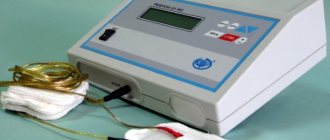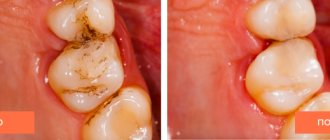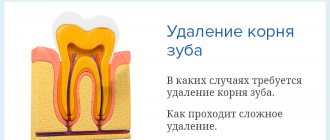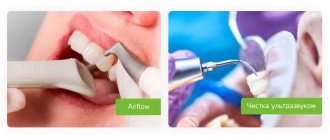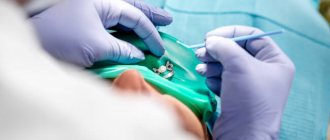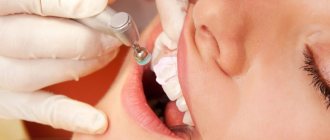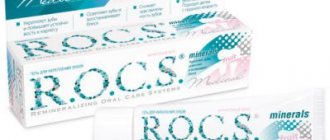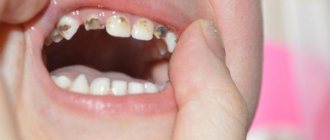Every person experiences tooth extraction sooner or later. The first experience was with baby teeth, but, as a rule, no problems arise with them, and they fall out safely even without medical assistance. But with permanent teeth the situation is different. Due to their complex root system, it is sometimes very difficult to remove them, and various additional techniques have to be used. Fortunately, modern dentistry has a whole range of modern methods that are low-traumatic and allow you to cope with even the most complex cases.
What are the indications for tooth extraction?
Tooth extraction in dentistry is always a last resort procedure. Doctors make every effort to save the tooth or at least part of it, but in some cases extraction cannot be avoided. We are talking about many conditions.
- Chronic periodontitis, which is in the acute stage. As a rule, if the inflammatory process continues to recur, it is recommended to remove the tooth to prevent further spread of the infection.
- Very strong and deep carious lesion of the tooth.
- Odontogenic osteomyelitis, which usually develops as a complication of infection and is characterized by damage to bone tissue.
- The tooth constantly injures soft tissues. This happens especially often if the tooth is in an incorrect position. Permanent trauma is very dangerous, therefore, if the problem cannot be solved in another way, removal is recommended.
- Fracture of a tooth root or any other mechanical damage.
- Late stages of periodontitis, when the teeth begin to become very loose.
- An impacted tooth that cannot erupt and is covered on top by gum tissue. Most often this happens with wisdom teeth.
- Carrying out orthopedic treatment or prosthetics that cannot be done without removing one or more teeth.
Indications
Mobility of dental units is divided into three degrees of severity:
- There is mobility of up to 1 mm in the horizontal direction.
- Tooth mobility is more than 1 mm in the horizontal direction.
- The most complex degree with mobility of dental units in both horizontal and vertical directions.
In the first and second stages, there is a chance to save the tooth with the help of strengthening, for example, splinting. Removal of the moving wall in the third degree is inevitable.
Important! If you find even a small crack or chip on a tooth, you should not delay visiting the dentist. The smaller the defect, the greater the chance of restoring the tooth without removing it.
Contraindications to tooth extraction
Of course, if the situation is urgent and tooth extraction is inevitable, the doctor will perform the procedure immediately after the patient seeks help. But if the operation is planned, then in some cases it is recommended to refrain from it. Contraindications include the following conditions:
- acute viral disease, pneumonia;
- oncology;
- some blood diseases;
- recent myocardial infarction;
- tumors and other lesions in the oral cavity.
In addition, tooth extraction is a procedure undesirable for pregnant women. But if it cannot be avoided, then doctors recommend, if possible, to carry it out in the second semester.
Is it expensive to remove a tooth root?
The cost of treatment depends on the location of the clinic and its status. Also a decisive factor is the qualifications and experience of the doctor. As a rule, the price includes:
- diagnostic measures at the preparatory stage;
- consultations with a dentist, anesthesiologist and other specialists;
- painkillers;
- the cost of the operation itself;
- materials used, etc.
Preparing for tooth extraction
For many people, tooth extraction is a very unpleasant and even frightening procedure. In fact, such fears are a consequence of those times when this manipulation was done without anesthesia using rough instruments. Today dentistry has stepped far forward, so removal takes place in much more comfortable conditions. You should not be afraid of the procedure, because the right psychological attitude is also one of the important conditions for the success of the operation.
To ensure that no incidents occur during tooth extraction, you must inform the surgeon about your state of health. If you have allergies, chronic or acute illnesses, be sure to tell your doctor. The same goes for the medications you take. Avoiding complications will also help avoiding alcohol and cigarettes the day before the procedure.
It is important to remember that you will not be able to eat or drink for some time after tooth extraction. Therefore, it is recommended to eat well before the procedure.
Anesthesia for tooth extraction
Tooth extraction is a rather painful procedure, so it is almost never performed without anesthesia. The exception is people with allergies to anesthetic drugs. Most often, when extracting teeth, local anesthesia is used using an injection. Usually we are talking about the so-called conduction anesthesia, which is injected directly into the nerve and has an increased concentration of the active substance. Naropin, ultracaine, ubistezin, etc. are used as the latter.
In addition to local anesthesia, general anesthesia may also be used during tooth extraction. Today, sedation is the most popular. This is a procedure in which the patient is given a strong sedative. He is in fact conscious, but does not feel pain and remains as if in a dream. Anesthesia is a more serious procedure that involves complete loss of consciousness, which in turn entails a longer recovery period.
General anesthesia for tooth extraction is used if the patient is intolerant to drugs for local anesthesia. In addition, it is used if a person has mental disorders, as well as if he experiences severe fear of the procedure. It is also justified if several teeth are to be removed at the same time. For example, sedation is often used when wisdom teeth are extracted. The procedure is done under the supervision of an anesthesiologist. Before the manipulation, the patient undergoes tests, performs a cardiogram and other procedures to diagnose the condition of the body.
How to pull out a tooth root at home
Despite the availability of modern surgical techniques and effective pain relief methods, some patients refuse to visit the clinic and prefer to perform the removal themselves. Pliers and other tools designed for everyday use, but not for dental work, come to the rescue. The base of the root part is picked up and removed. Doctors categorically do not recommend doing this under any circumstances. The fact is that the process is associated with a high risk of complications and can lead to irreversible consequences.
Is it possible to pull out the root of a tooth on your own, as experts explain?
As stated above, dentists agreed that extraction at home poses a serious threat to the health of the person who decides to do it. What happens if you ignore these recommendations:
- the open wound becomes infected, which can subsequently lead to sepsis;
- traumatic shock occurs from pain, severe stress develops;
- fragments remain in the hole, it is very rarely possible to get them completely at home, suppuration occurs, and the risk of serious dental pathologies increases;
- intense bleeding appears.
Before removing an overgrown tooth root if it is broken, it is necessary to undergo a high-quality diagnosis and develop a treatment regimen together with a doctor. Only a specialist can choose the appropriate technique and recommend a method of pain relief. Complications after extraction are rare if the procedure is performed in a clinical setting. Self-pulling can lead to serious problems, including sepsis.
What methods of tooth extraction are used?
In modern dentistry, different methods of tooth extraction are used. In most cases, the choice of one method or another depends on the characteristics of a particular situation.
Simple method
In this case, we are talking about removing a tooth with a well-preserved crown, which is located in an accessible place. And although extraction is carried out exclusively by surgeons, such manipulation, especially in public clinics, is often performed by dental therapists.
During tooth extraction, a specialist uses different instruments. First of all, these are tongs. They vary depending on what teeth they are used for. For example, there are S-shaped forceps that are used to remove premolars and molars in the upper jaw, or forceps that are used to remove exclusively lower molars. In addition to forceps, luxors and elevators are also used, which perform the functions of lever tools.
Direct tooth extraction can occur in different scenarios. So, when extracting a single-rooted tooth, the doctor uses a technique called rotation. It involves rotating the tooth around its axis, which allows you to quickly remove the element. If the tooth is multi-rooted, then luxation or rocking is necessary. Thanks to gradual loosening movements, the doctor gradually extracts the tooth along with the root.
Complex method
Complex extractions are usually performed on multi-rooted teeth. The fact is that sometimes even prolonged swinging of the tooth does not produce results. In such a situation, the specialist uses a drill and saws the tooth, separates the roots and gradually removes all the parts. A similar procedure is also often used when the crown of the tooth is severely damaged or there are other serious problems, for example, the root system is too thin and fragile. The situation is even more complicated if the tooth is completely or partially impacted or is in an incorrect position. In particular, this often happens with wisdom teeth. In such a situation, it is necessary to first cut through the soft tissue and only then saw the tooth itself.
Piezosurgery
This method is innovative, so it is not yet widespread. Piezosurgery is usually used to remove complex teeth. In this case, the tissue incision is made with an ultrasonic scalpel. This method is much less traumatic, since ultrasound in no way directly comes into contact with tissues. Thus, the patient recovers much faster than after conventional surgery.
Laser tooth extraction
As in the case of piezosurgery, in this case the tooth is removed not with conventional instruments, but with the help of a laser beam. This is also a non-contact technique associated with less blood loss and less risk of injury. In addition, the pain of the procedure itself when using a laser is much lower, so this option is suitable for people who suffer from allergies to anesthetics. Unfortunately, both piezosurgery and the use of laser are quite expensive manipulations, so they are not yet performed widely.
Possible complications and their prevention.
Like most surgical procedures, tooth extraction is associated with certain risks.
Bleeding
There are two types: primary and secondary. Immediately after surgical trauma, blood begins to flow from the damaged vessels of soft tissue and bone. In acute inflammation, bleeding is more severe. After 1–2 hours, the process may resume due to the fact that the vasoconstricting anesthetics cease to act. It is very important for the patient to inform the doctor about any bleeding disorders - hemophilia, vitamin C deficiency, etc. The surgeon will choose the least traumatic protocol and take measures to stop the bleeding.
Alveolitis
Inflammation of the walls of the socket. At an early stage it manifests itself in the form of aching pain when eating. Subsequently, the pain intensifies and swelling appears. In the absence of proper measures, serious complications are inevitable: periostitis, osteomyelitis of the jaw, abscess, phlegmon. Alveolitis can develop either as a result of a doctor’s error (careless removal of granulations and tooth fragments from the socket), or due to the fault of a patient who violates the postoperative regime.
Exposure of the alveolus
Sometimes, when a tooth is extracted, the alveolar process loses part of its mucous membrane. On the outside there is an exposed bone that reacts with pain to hot or cold food and even touch. In such a situation, the surgeon needs to remove the protruding area and close the wound with a mucosal flap [1].
Tooth extraction procedure: what is important to know?
The removal of each tooth can take place according to a different scenario. To predict it, the doctor conducts an examination and also takes an x-ray. In most cases, removing teeth from the upper jaw is easier and faster, but teeth on the lower jaw can create certain problems. This is explained by the fact that the lower chewing teeth have a much more complex root system. In addition, the bone tissue itself is denser here.
Also, before the procedure, it is important for the patient to prepare for how long it may last. As a rule, simple tooth extraction goes very quickly. The doctor needs 5-10 minutes to carry out all the manipulations. However, if we talk about complex removal, then in this case the time spent in the office may last for 20-60 minutes.
What is the difference between complex removal and simple removal?
- The first difference is that complex removal takes much longer. A dentist can simply remove a tooth in 5–10, or maximum 20 minutes. But complex removal sometimes lasts for half an hour or even an hour.
- The second significant difference is the use of special tools. For simple removal, forceps are usually sufficient; for complex removal, elevators and other tools are used. Sometimes they look threatening, but in fact they are designed to cause as little discomfort to the patient as possible and minimal trauma to the tissue.
- The third difference is the need to cut the gum. With a simple extraction, it is usually enough just to pull out the tooth, but with a complex extraction, parts of it are hidden deep under the gums - in the bone, so you have to make incisions and then apply sutures. This, in turn, leads to a more difficult and longer recovery period.
- The last important difference is that after a complex extraction, the gums hurt more, and the risk of complications is higher. Therefore, it is important to take all medications prescribed by your doctor and maintain good hygiene.
What care is required after tooth extraction?
Regardless of whether you had a simple or complex tooth extraction, such a situation requires monitoring your well-being and the wound surface on the gum. First of all, this concerns the proper healing of the hole. Ideally, a blood clot should form in it, which indicates that healing is proceeding without problems. It is for this purpose that the doctor immediately after the procedure places a gauze swab into the resulting cavity. It must be kept in the indicated place without removing it for 20-30 minutes, and only after that can it be removed. If the hole has formed correctly, then in a couple of days it will be covered with epithelium, and after a couple of months new bone tissue will appear in its place.
In order not to interfere with the proper healing of the wound, you must follow the following recommendations:
- Do not rinse your mouth for a couple of days or use a toothbrush in the area where the tooth was removed;
- For the first time after the procedure, avoid hot drinks and food;
- do not take a hot shower or bath for 2-3 days after tooth extraction;
- for the first few hours, completely abstain from food and drinks;
- Until the wound heals completely, try to chew on the other side of your mouth.
Many people experience swelling in the area where the tooth was removed, which can last for several days. To make it less pronounced, it is recommended to apply ice to the cheek after the procedure. Minor pain and low-grade fever may also be a concern. This is considered normal, and to alleviate the condition, the doctor prescribes painkillers. He may also prescribe an antibiotic if in a particular case he considers its use justified. In such a situation, it is extremely important to undergo a full course of treatment in strict accordance with the doctor’s recommendations.
What to do if you have pain
In the first 5–7 days, the gums will definitely hurt. This is a normal reaction to a serious intervention, so there is no need to panic. To relieve pain, your doctor will prescribe pain medications, possibly even prescription ones. You should not take painkillers without a doctor's prescription - they can cause bleeding and other complications.
Over the course of this week, the pain should gradually subside. If it gets worse and the gums at the extraction site become red and swollen, this may be a sign of inflammation. If the pain is severe, you should visit the dentist.
If the pain does not go away after 7 days, it is better to consult a doctor. This happens when an infection enters a tooth. If you don't see a doctor right away, it can cause inflammation of your jawbone.
Expert of the article you are reading:
Lyubomskaya Olesya Alekseevna
Dental surgeon-implantologist, dental therapist, dentist - orthopedist (K.M.N.) (Candidate of Medical Sciences).
You may also be interested in:
Wisdom tooth removal Tooth extraction Removal of the dental nerve Resection of the apex of the tooth root Removal of an impacted tooth Removal of the tooth root Removal of a dystopic tooth Excision of the hood
Show more
Possible complications after tooth extraction
In some cases, tissue healing after tooth extraction does not occur correctly, or an infection is observed. In this situation, we talk about complications after surgery. They are indicated by severe pain, great swelling, and elevated temperature. If pathogenic microflora gets into the wound, then bad breath and purulent discharge may also appear. The listed symptoms may indicate a cyst or fistula.
A common complication after tooth extraction is alveolitis. This condition is accompanied by a dry socket, that is, the absence of a blood clot. The main sign of pathology is quite severe pain. Alveolitis is most often diagnosed in women taking contraceptives and in people who smoke.
The development of complications after tooth extraction is often a consequence of neglecting the doctor’s recommendations. In addition, the reason may be related to poorly performed manipulation or low qualifications of the doctor. That is why it is always important to contact experienced specialists who master modern techniques and cope well with even the most complex and extraordinary cases.
come back
Prices for services
Simple permanent tooth extraction from RUB 2,000.
Complex permanent tooth extraction from RUB 3,000.
Tooth extraction with detachment of the mucoperiosteal flap from RUB 3,500.
Inspection after removal 0
Removal of 1st supernumerary tooth from RUB 3,000.
Removal of a dystopic tooth from RUB 4,500.
Removal of impacted and dystopic teeth from RUB 5,000.
Removal of a tooth fragment from RUB 1,000.
Removal of a baby tooth from 700 rubles.
Initial doctor's appointment 0 rub.
